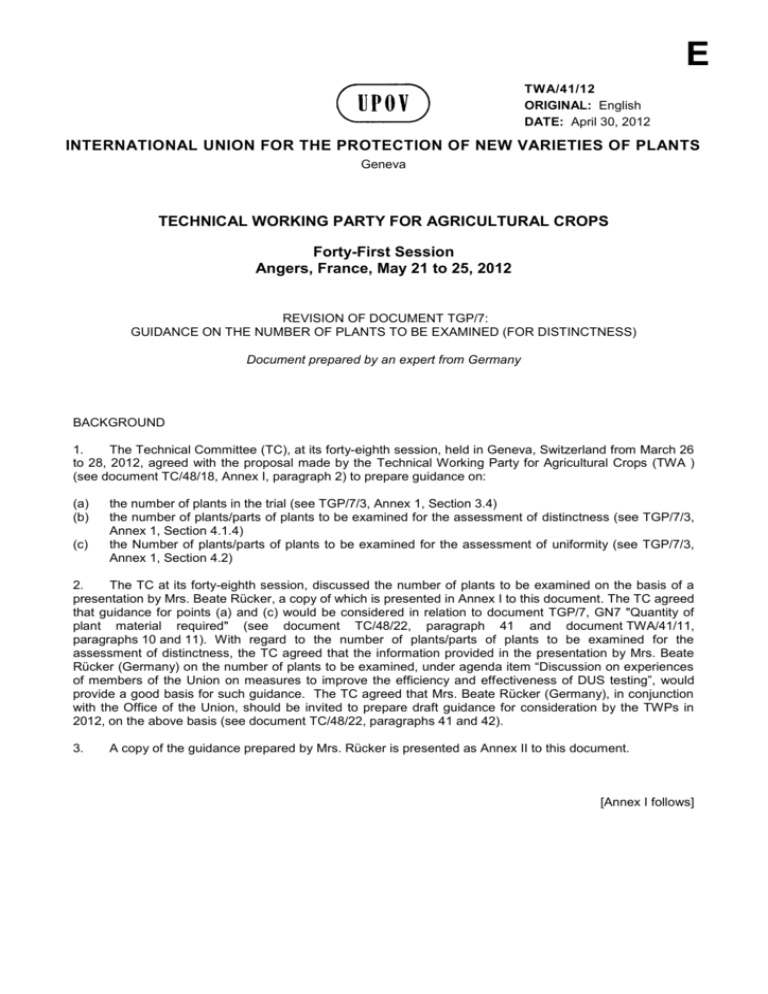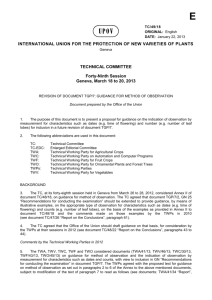Guidance on the Number of Plants to be Examined
advertisement

E TWA/41/12 ORIGINAL: English DATE: April 30, 2012 INTERNATIONAL UNION FOR THE PROTECTION OF NEW VARIETIES OF PLANTS Geneva TECHNICAL WORKING PARTY FOR AGRICULTURAL CROPS Forty-First Session Angers, France, May 21 to 25, 2012 REVISION OF DOCUMENT TGP/7: GUIDANCE ON THE NUMBER OF PLANTS TO BE EXAMINED (FOR DISTINCTNESS) Document prepared by an expert from Germany BACKGROUND 1. The Technical Committee (TC), at its forty-eighth session, held in Geneva, Switzerland from March 26 to 28, 2012, agreed with the proposal made by the Technical Working Party for Agricultural Crops (TWA ) (see document TC/48/18, Annex I, paragraph 2) to prepare guidance on: (a) (b) (c) the number of plants in the trial (see TGP/7/3, Annex 1, Section 3.4) the number of plants/parts of plants to be examined for the assessment of distinctness (see TGP/7/3, Annex 1, Section 4.1.4) the Number of plants/parts of plants to be examined for the assessment of uniformity (see TGP/7/3, Annex 1, Section 4.2) 2. The TC at its forty-eighth session, discussed the number of plants to be examined on the basis of a presentation by Mrs. Beate Rücker, a copy of which is presented in Annex I to this document. The TC agreed that guidance for points (a) and (c) would be considered in relation to document TGP/7, GN7 "Quantity of plant material required" (see document TC/48/22, paragraph 41 and document TWA/41/11, paragraphs 10 and 11). With regard to the number of plants/parts of plants to be examined for the assessment of distinctness, the TC agreed that the information provided in the presentation by Mrs. Beate Rücker (Germany) on the number of plants to be examined, under agenda item “Discussion on experiences of members of the Union on measures to improve the efficiency and effectiveness of DUS testing”, would provide a good basis for such guidance. The TC agreed that Mrs. Beate Rücker (Germany), in conjunction with the Office of the Union, should be invited to prepare draft guidance for consideration by the TWPs in 2012, on the above basis (see document TC/48/22, paragraphs 41 and 42). 3. A copy of the guidance prepared by Mrs. Rücker is presented as Annex II to this document. [Annex I follows] TWA/41/12 ANNEX I Experiences of Members of the Union in Measures to Improve the Efficiency and Effectiveness of DUS Testing Number of Plants to be Examined Beate Rücker, Germany Geneva, March 26, 2012 Number of plants specified in the Test Guidelines (see TGP/7/3) (a) Number of plants in the trial (Annex 1, Section 3.4) (b) Number of plants/parts of plants to be examined for the assessment of distinctness (Annex 1, Section 4.1.4) (c) Number of plants/parts of plants to be examined for the assessment of uniformity (Annex 1, Section 4.2) TC agreed that guidance should be drafted for these numbers of plants for inclusion in a future revision of TGP/7. TWA/41/12 Annex I, page 2 (a) Number of plants in the trial plot size in order to ensure a typical expression of the characteristics in the varieties – biological and agronomic elements number of plants to be observed for the identification of the typical expression taking into account variation between plants (within the limits of a uniform variety) – distinctness, variety description, stability number of plants to be observed for the assessment of uniformity under consideration of the genetic structure of the variety Limiting element depends on the crop, in general the following number of plants apply: Trial ≥ Uniformity ≥ Distinctness (b) Number of plants/parts of plants to be examined for the assessment of distinctness Aim is the observation of the “typical” expression of characteristics in the given environment Critical element is the precision of the observed (mean) expression of the varieties to be compared – important for the consideration what difference is a clear difference QL: Low number of plants sufficient – not limiting for the number of plants in the trial, definition in TG not crucial for harmonisation QN: Precision of records influenced by sample size important for candidate and similar variety – guidance necessary for harmonisation TWA/41/12 Annex I, page 3 Considerations for the number of plants to be observed for distinctness in case of QN (PQ) Sample size important because of the relation between SD and LSD. Variation within the variety has to be taken into account for defining a clear difference (by experts judgment or exact statistics ). Observation on the plot as a whole (VG/MG) – indicated number to be considered as minimum number Observation on subsample from plot (VG/MG) – indicated number to be considered as minimum number Observations on individual plants (VS/MS) – number of plants important for precision of record – specific number to be indicated Considerations for the number of plants for candidate varieties and varieties to be compared with If uniformity has not to be observed for similar varieties of common knowledge (reference varieties), it can be considered to include in the trial a lower number of plants for the reference varieties. Example: Grapevine (German Protocol) Number of plants/parts of plants for distinctness: Number of plants/parts of plants for uniformity: 4 plants 8 plants Number of plants in the trial: 8 plants for candidate varieties 4 plants for varieties in the variety collection Remark: Some reference varieties are maintained with less than 4 plants in the permanent collection (sufficient as long as there are very big differences to all candidates). If a candidate is very similar to one of those reference varieties, the latter will be re-planted with 4 plants in the same age as the candidate for direct comparison. TWA/41/12 Annex I, page 4 (c) Number of plants/parts of plants to be examined for the assessment of uniformity Genetic structure of variety, features of propagation Uniformity Method (off-types, variance) Off-types: Population standard (consideration error alpha and beta) Not relevant for number of plants for reference varieties Variance:Variance influenced by sample size (specific number to be defined for harmonisation) Relative variance methods, incl. COYU (number of plants relevant for candidates and reference varieties) Thank you! [Annex II follows] TWA/41/12 ANNEX II GUIDANCE NOTE TO BE INCLUDED IN TGP/7, SECTION 4.1.4 1. The observation of the 'typical' expression of characteristics of a variety in a given environment is essential for the assessment of distinctness. The precision of the observed (mean) expression of the varieties to be compared is a critical element for the consideration of whether a difference is a clear difference. 2. In the case of qualitative characteristics, a low number is sufficient to identify the expression of a variety. In general, the number of plants for the assessment of distinctness is not a limiting factor for the number of plants in the trial. Thus, the number of plants for the assessment of qualitative characteristics is not essential for harmonization. 3. In case of qualitative characteristics (and pseudo-qualitative characteristics), the variation within the variety has to be taken into account for defining a clear difference (by expert judgment or exact statistics). Due to the relation between variation within the varieties and the required difference to be considered as a clear difference for the establishment of distinctness the precision of records is important. The precision of records (mean values) is influenced by the sample size. Therefore, the appropriate sample size should be indicated in the Test Guidelines for the purpose of harmonization. 4. The following general principals should be taken into account: Considerations for the number of plants to be observed for distinctness in case of QN (PQ) (a) Observation on the plot as a whole (VG/MG) – the indicated number should be considered as minimum number (b) Observation on subsample from plot (VG/MG) – the indicated number should be considered as minimum number (c) Observations on individual plants (VS/MS) – the number of plants is important for precision of record – the specific number should be indicated Considerations for the number of plants for candidate varieties and varieties to be compared with the candidate varieties If two varieties are very similar it is important to ensure a similar precision of the records for both varieties. The number of plants indicated in the Test Guidelines apply to the candidate variety and to the similar variety as well. The precision of records is not that crucial if the difference between two varieties to be compared is very clear. In that case it may be possible to include in the trial a lower number of plants for the similar varieties (varieties in the variety collection), provided that uniformity does not have to be assessed for these varieties. [End of Annex II and of document]






